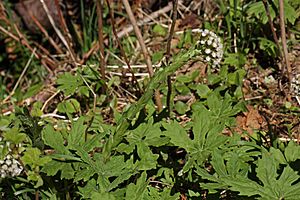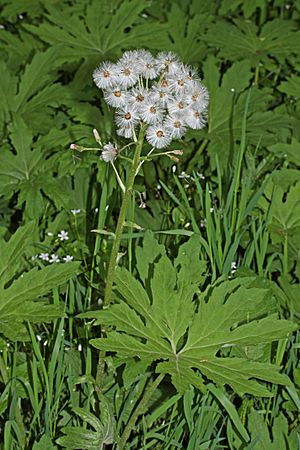Arctic sweet coltsfoot facts for kids
Quick facts for kids Arctic sweet coltsfoot |
|
|---|---|
 |
|
| Arctic sweet coltsfoot | |
| Scientific classification | |
| Genus: |
Petasites
|
| Species: |
frigidus
|
| Synonyms | |
|
|
Petasites frigidus, the Arctic sweet coltsfoot or Arctic butterbur, is a species of flowering plant in the daisy family Asteraceae. It is native to Arctic to cool temperate regions of the Northern Hemisphere in northern Europe, northern Asia and northern North America.
It is a herbaceous perennial plant producing flowering stems in early spring, and large leaves through the summer. The upright flowering stems are 10–20 cm tall, and bear only 5-12 inflorescences, yellowish-white to pink in colour. The leaves are rounded, 15–20 cm broad, with a deeply cleft base and shallowly lobed margin, and rise directly from the underground rootstock. The underside of the leaves is covered with matted, woolly fuzz. It grows in moist shaded ground, preferring stream banks and seeping ground of cut-banks.
While there is some disagreement, some sources identify five varieties of P. frigidus:
- Petasites frigidus var. frigidus
- Petasites frigidus var. nivalis, sometimes referred to as P. nivalis or P. hyperboreus. This variety is common at subalpine and alpine elevations.
- Petasites frigidus var. palmatus, sometimes referred to as P. palmatus, palmate coltsfoot, or western coltsfoot; mâl-ē-mē’ (Konkow language); or tä-tä-tē’; pē’-wē is the root.
- Petasites frigidus var. sagittatus, arrowleaf sweet coltsfoot.
- Petasites frigidus var. vitifolius
Uses
The leaf stalks and flower stems (with flowers) are edible, and can be used as a vegetable dish. A salt-substitute can also be made by drying and then burning the leaves. This black, powdery substance will provide a salty taste. However, given the high likelihood of the presence of toxic unsaturated, diester pyrrolizidine alkaloids in this species, consumption should be very limited.
See also
 In Spanish: Petasites frigidus para niños
In Spanish: Petasites frigidus para niños


